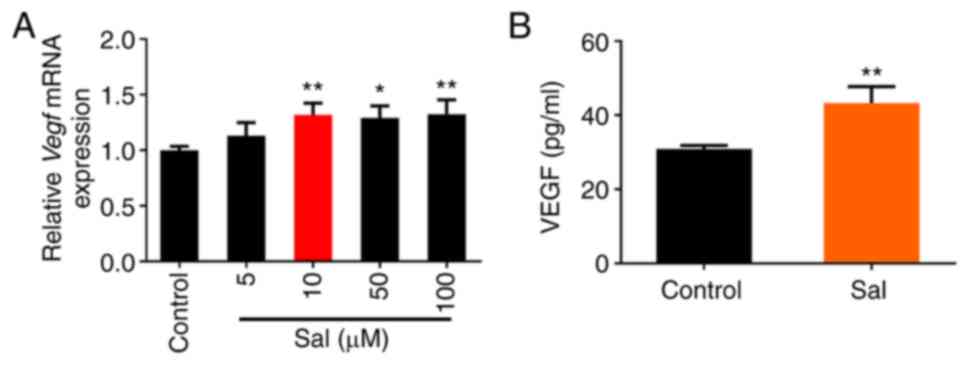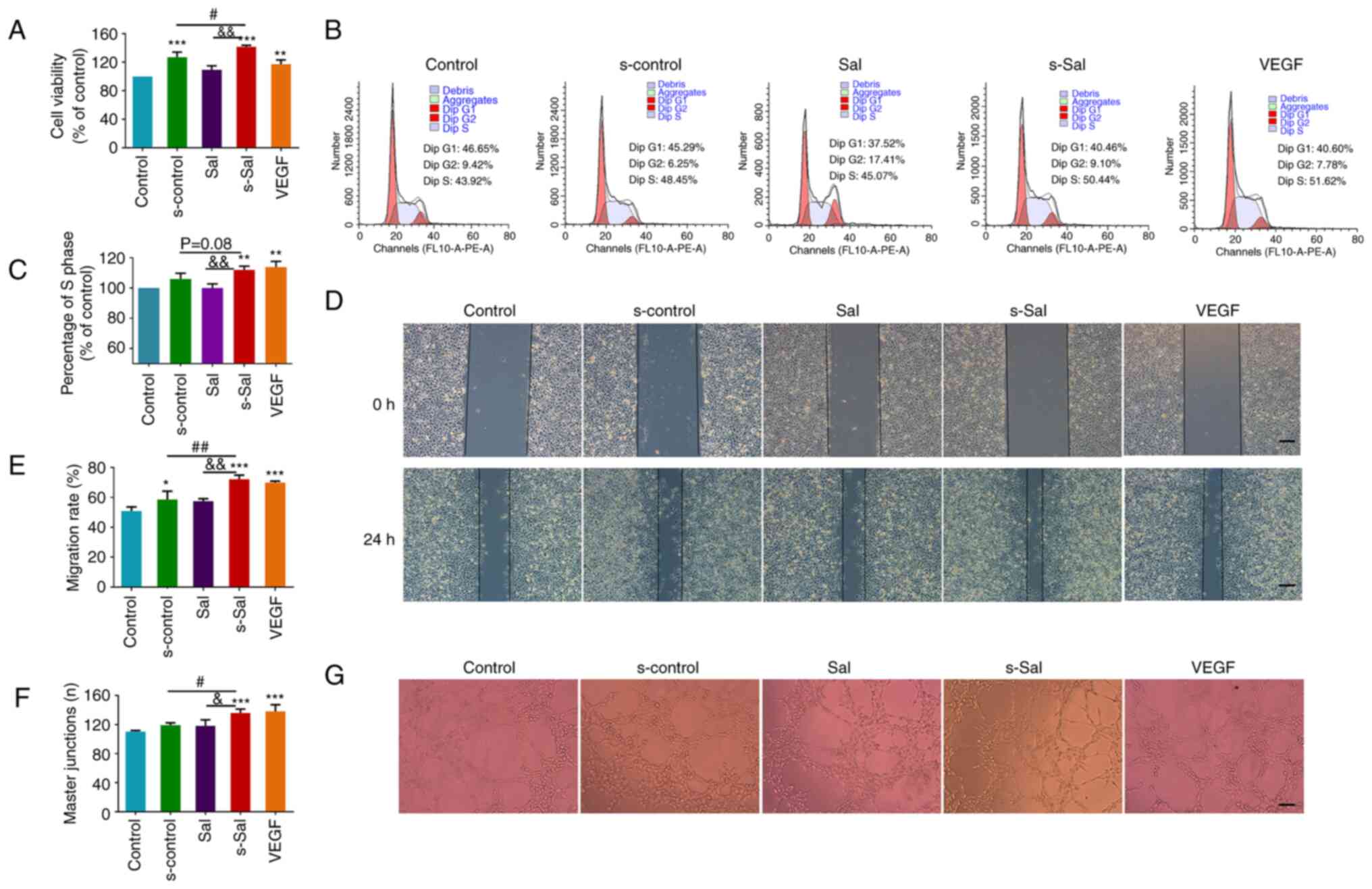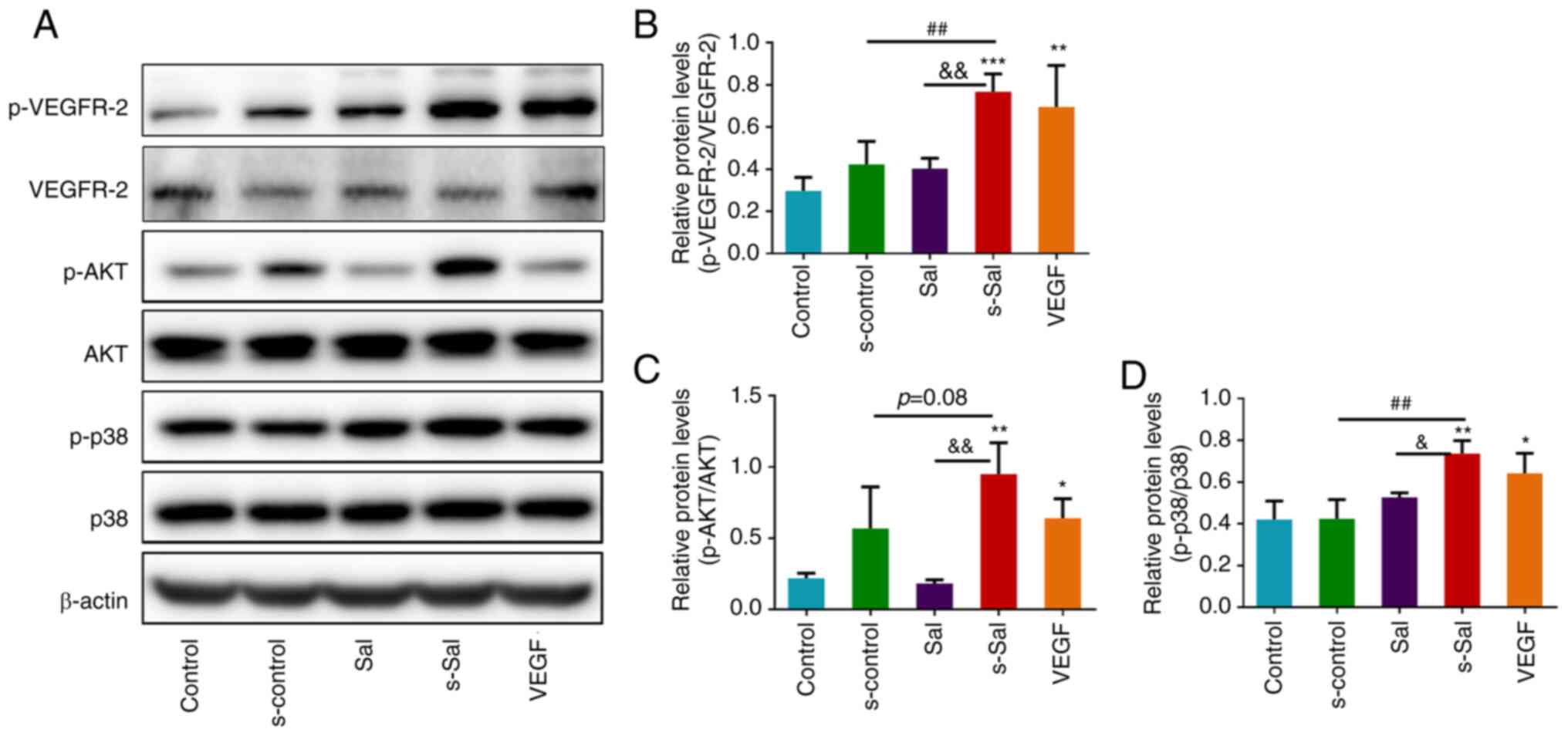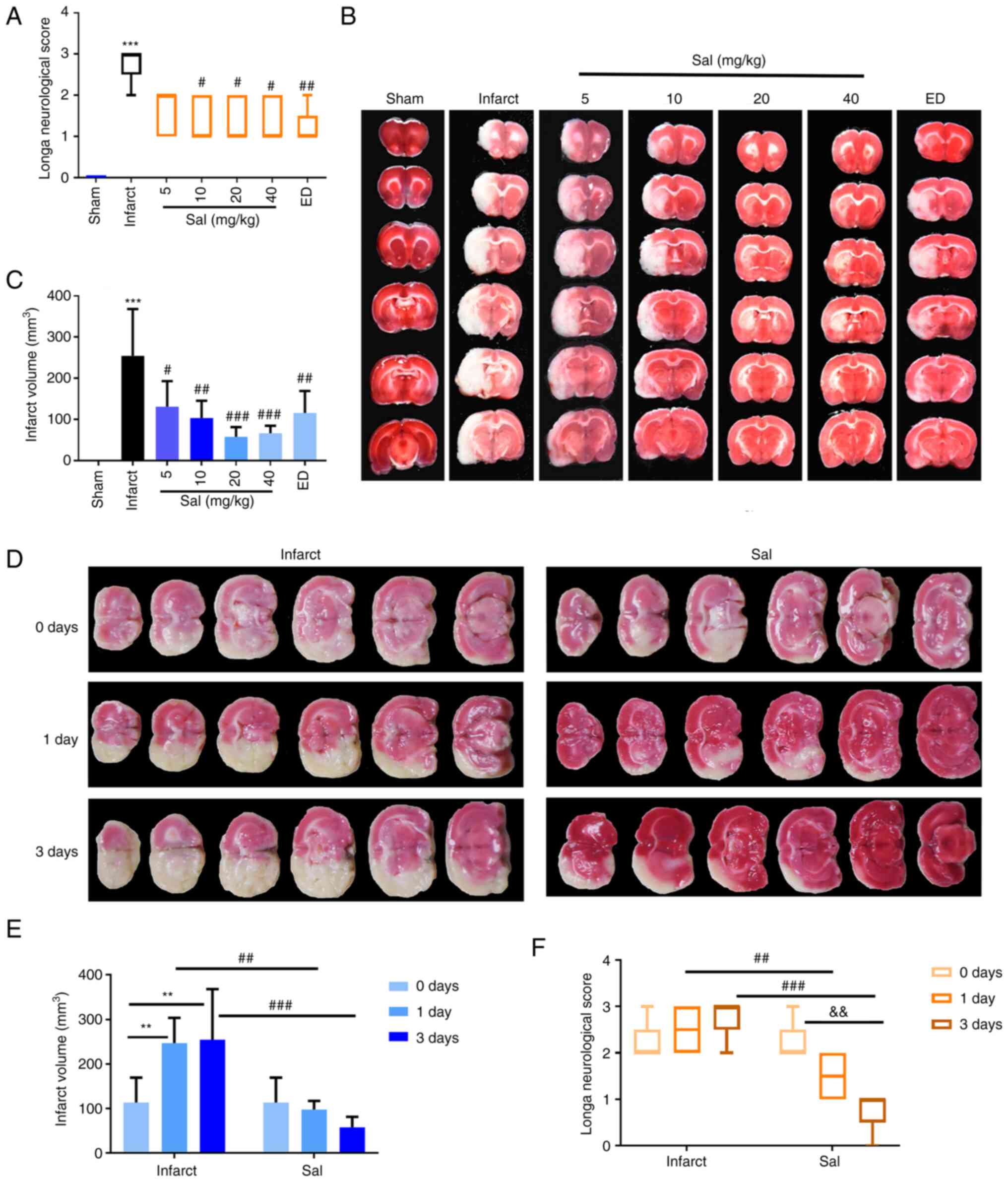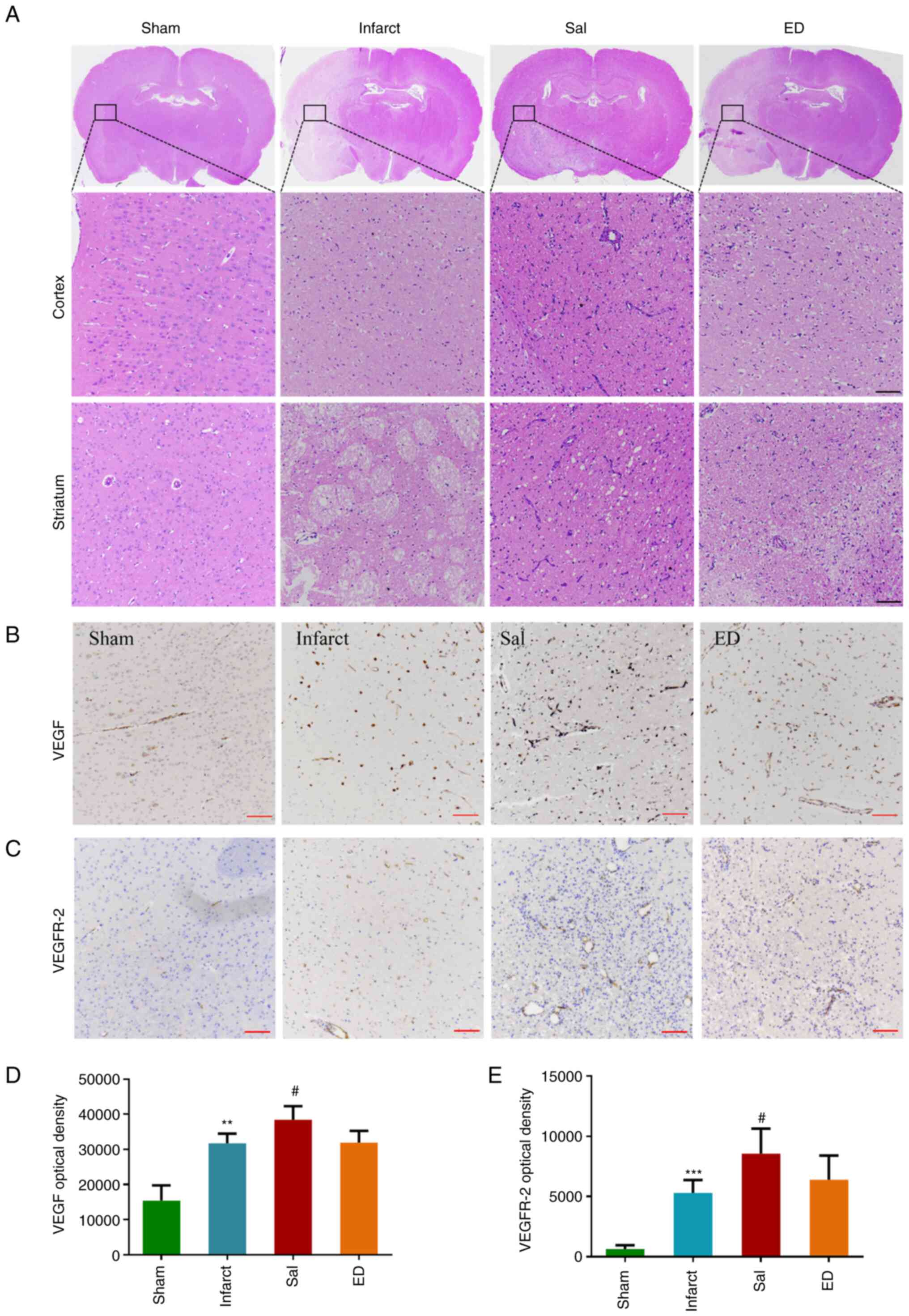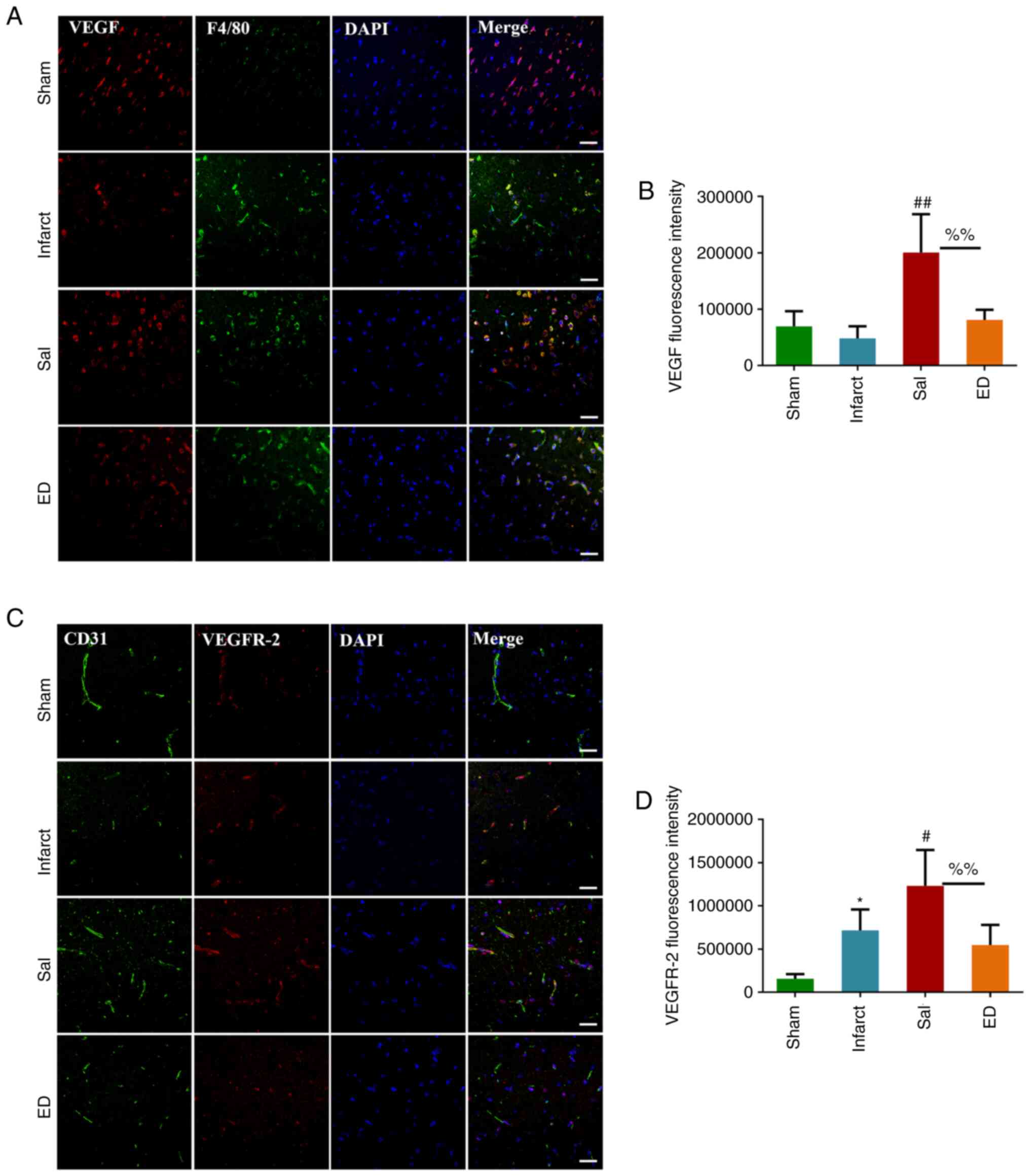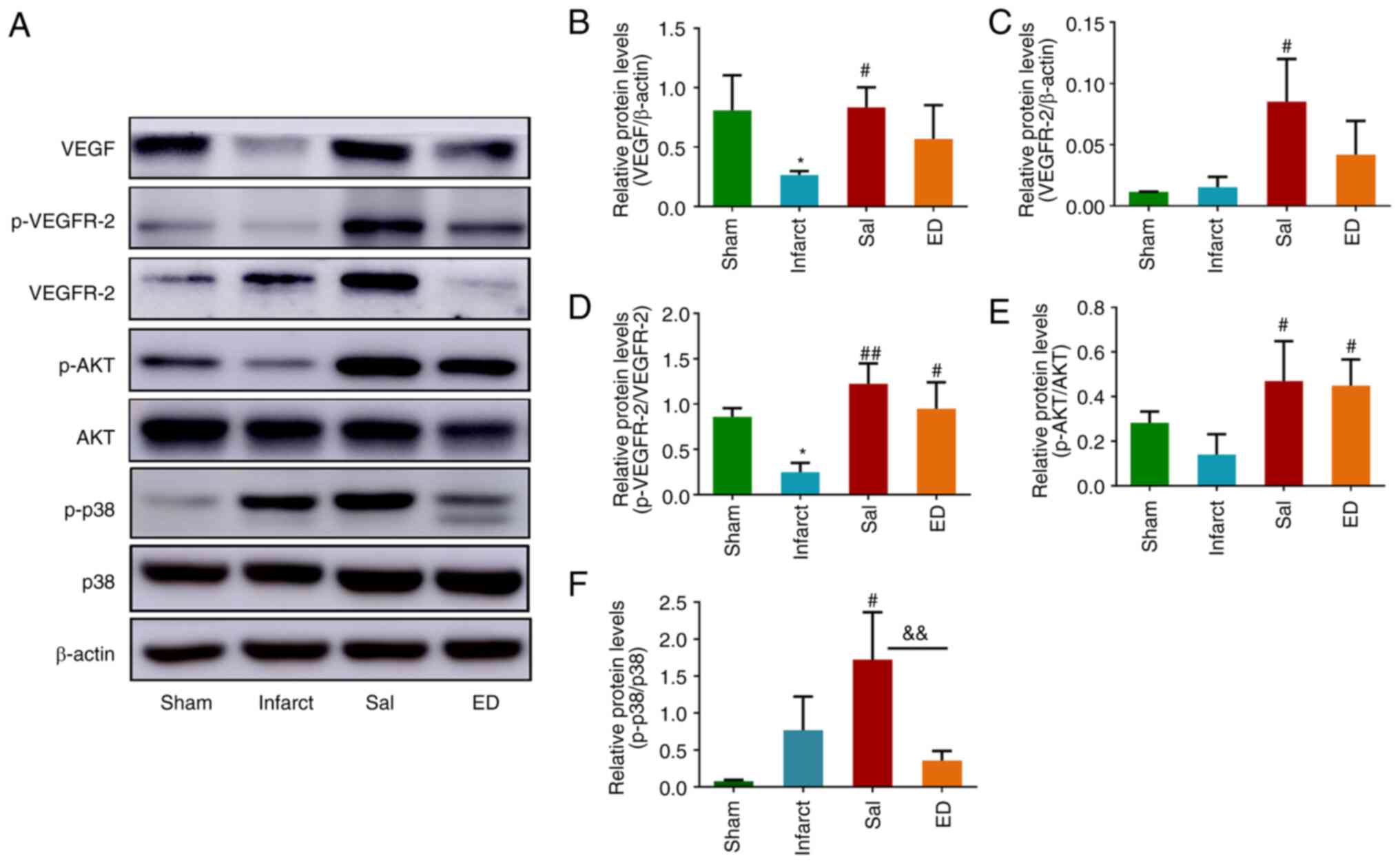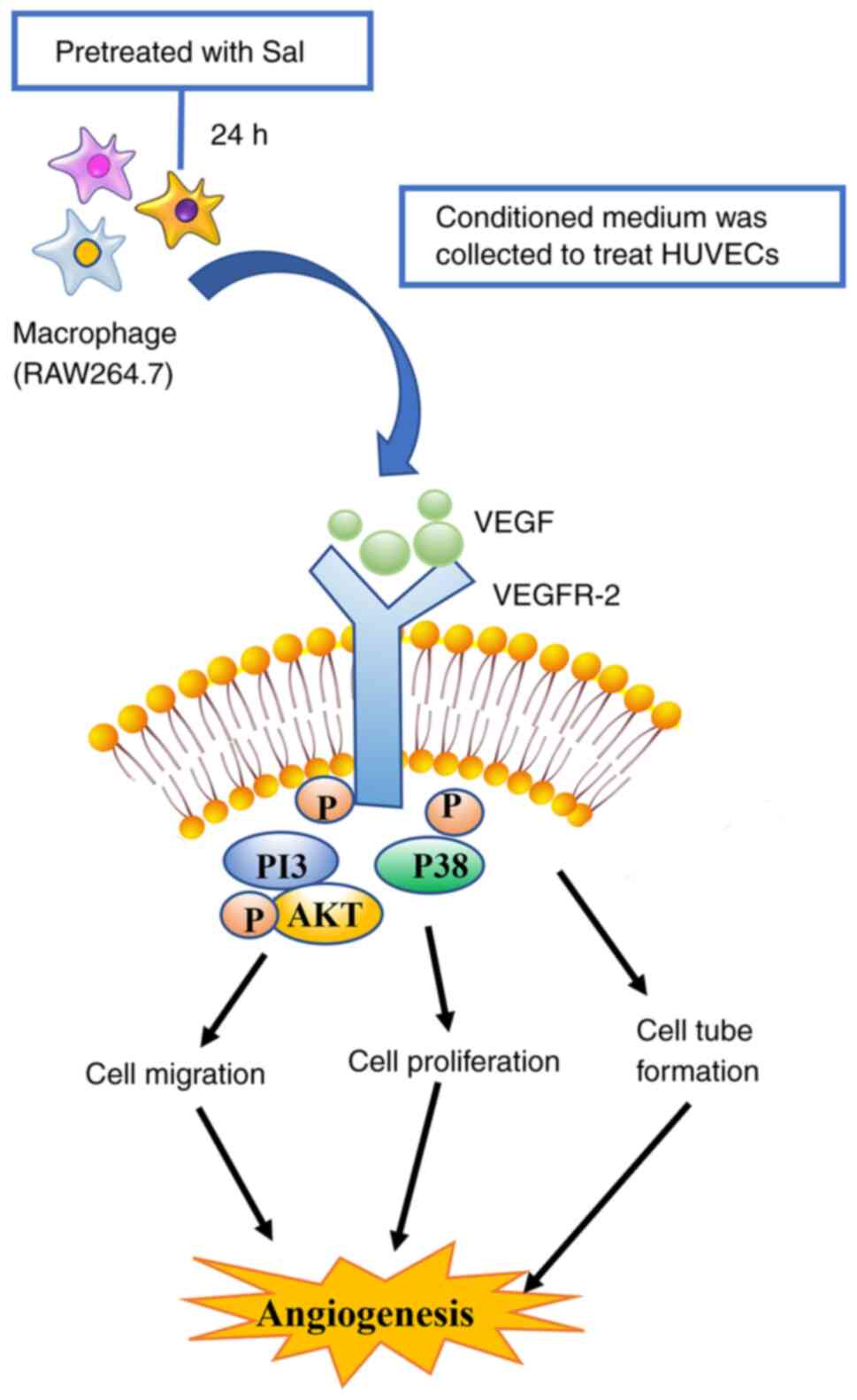Pro‑angiogenic activity of salvianolate and its potential therapeutic effect against acute cerebral ischemia
- Authors:
- Published online on: July 10, 2023 https://doi.org/10.3892/etm.2023.12108
- Article Number: 409
-
Copyright: © Xu et al. This is an open access article distributed under the terms of Creative Commons Attribution License.
Abstract
Introduction
Stroke is a leading cause of long-term disability among adults and is the third most frequent cause of mortality worldwide. However, no effective treatments are currently available for facilitating recovery from stroke (1,2). Ischemic stroke, which constitutes 80% of all stroke cases, is the most common type of stroke and results from focal cerebral ischemia caused by the occlusion of major cerebral arteries (3). Ischemic stroke is a serious neurological condition that occurs via a complex and varied pathophysiological process, the fine pathophysiological mechanism of which remains to be fully elucidated (4-6). Therefore, it is necessary to devise a novel, safe and effective method that can be used for early stroke treatment as well as for the recovery of motor function lost at the latter stages of stroke.
Angiogenesis, which involves the formation of new blood capillaries from pre-existing blood vessels, serves an important role in the process of tissue remodeling after ischemic stroke (7-9). The reconstruction of new functional microvasculature has been documented to promote recovery from stroke, with angiogenesis being pivotal for repair following ischemic brain injury because it stimulates blood flow and metabolism in the ischemic boundary (10). In addition, angiogenic vessels secrete neurotrophic factors and chemokines, which may create a suitable microenvironment within the damaged brain to support the survival of newly formed neurons (11).
Damage to the brain by cerebral ischemia/reperfusion (I/R) involves multiple reactions, including inflammatory reactions and oxidative damage, and a large number of immune cells, such as macrophages, are typically recruited to the site of injury (12). These macrophages secrete various angiogenic growth factors, including vascular endothelial growth factor (VEGF), basic fibroblast growth factor and MMP-9 that promote angiogenesis, which can preserve cortical blood supply and improve neurological function during the acute phase of cerebral I/R (13-15). VEGF is an important promoter of post-ischemia neurovascular remodeling (16,17). Ischemia stimulates VEGF expression in the brain (18), thereby promoting the formation of new cerebral blood vessels (19). Furthermore, VEGF has been found to exert mitogenic and anti-apoptotic effects on endothelial cells, which can increase vascular permeability and promote cell migration (20). Among known angiogenic signaling pathways, the VEGF/VEGF receptor-2 (VEGFR2) pathway is especially important, since it can determine when angiogenesis is initiated, the degree of angiogenesis and the type of blood vessels formed. This in turn contributes to the maintenance of normal blood vessel morphology whilst preventing endothelial cell apoptosis. Previous studies have shown that VEGFR2 serves a leading role in the angiogenesis mediated by VEGF (21). Following the binding of VEGF to VEGFR2, autophosphorylation of the receptor occurs, which then activates the downstream MAPK and PI3K/AKT signaling pathways to regulate the migration, survival and proliferation of endothelial cells. This in turn promotes angiogenesis (21).
Salvianolate (Sal) is a medicinal composition derived from the principal active constituents of Danshen. It has been shown to contain magnesium lithospermate B (≥85%), rosmarinic acid (≥10.1%) and lithospermic acid (≥1.9%) (22-24). Danshen is the dried root of the well-known Chinese herb Salvia miltiorrhiza Bunge (Labiatae). Due to its ability to promote blood circulation, it is widely used for the treatment of various cardiovascular diseases, including coronary heart disease and angina pectoris, in China (25-27).
In the present study, the potential effects of Sal on endothelial cell and macrophage function and intracellular signaling were investigated in vitro. Furthermore, the rat transient middle cerebral artery occlusion (tMCAO) model was used to evaluate the effects of Sal on acute cerebral ischemia in vivo.
Materials and methods
Reagents and antibodies
Sal (batch no. 17111321) was obtained from Shanghai Green Valley Pharmaceutical Co., Ltd. DMEM was purchased from Gibco (Thermo Fisher Scientific, Inc.). FBS was purchased from Serana Europe GmbH. VEGF protein (cat. no. 100-20) was purchased from PeproTech, Inc. The rabbit monoclonal antibody against phosphorylated (p)-VEGFR2 (cat. no. 3770), rabbit monoclonal antibody against VEGFR2 (cat. no. 9698), mouse monoclonal antibody against β-actin (cat. no. 3700), rabbit monoclonal antibody against p-AKT (cat. no. 4060), rabbit monoclonal antibody against AKT (cat. no. 4696), rabbit anti-p38 MAPK monoclonal antibody (cat. no. 8690) and rabbit anti-p-p38 monoclonal antibody (cat. no. 4511) were purchased from Cell Signaling Technology, Inc. The mouse anti-F4/80 (C-7) monoclonal antibody (sc-377009) and rabbit anti-VEGF polyclonal antibody (sc-7269) were purchased from Santa Cruz Biotechnology, Inc. The rabbit anti-CD31 polyclonal antibody (GB12063) was purchased from Wuhan Servicebio Technology Co., Ltd. Horseradish peroxidase (HRP)-conjugated goat anti-mouse (A0216) and goat anti-rabbit (A0208) secondary antibodies were purchased from Beyotime Institute of Biotechnology.
Animals
All animal protocols and procedures were approved by the Shanghai University of Traditional Chinese Medicine Institutional Animal Care and Use Committee (grant no. PZSHUTCM200320004). All experiments were performed in accordance with the guidelines described in the Regulations for the Administration of Affairs Concerning Experimental Animals of China enacted in 1988. A total of 97 healthy male Sprague-Dawley rats (8 weeks old; weight, 300±20 g) were purchased from Shanghai Sino-British SIPPR/BK Lab Animal Co., Ltd. The rats were individually caged in a climate-controlled room (20-26˚C, relative humidity of 40-70%) housed under a 12-h dark/light cycle, and allowed free access to water and food. The animals were fasted without water deprivation for 12 h before the tMCAO procedure was performed.
Cell culture
Human umbilical vein endothelial cells (HUVECs; American Type Culture Collection HUV-EC-C cell line, cat. no. CRL-1730) were obtained from the Cancer Research Institute of Central South University. The murine RAW264.7 cell line was purchased from the Institute of Biochemistry and Cell Biology, Chinese Academy of Sciences. Both types of cells were cultured in DMEM containing 10% FBS at 37˚C in a humidified atmosphere comprising 5% CO2 in an incubator.
Preparation of the RAW264.7 cell supernatant
RAW264.7 cells (~3x106 cells/ml) were seeded into cell culture dishes (60x15 mm) and incubated for 24 h. The cells were then incubated in medium without or with Sal (10 µM) at 37˚C. After culturing for 24 h, the medium was collected and centrifuged (3,500 x g) to remove cell debris. The following solutions were then collected: i) s-control, comprising the supernatant of RAW264.7 cells; and ii) s-Sal, comprising the supernatant of Sal (10 µM)-treated RAW264.7 cells.
Cell treatment and groups
In total, the following five groups were designated for the treatment of HUVECs: i) Control group, untreated HUVECs; ii) s-control group, where the HUVECs were treated with supernatant of RAW264.7 cells; iii) Sal group, where the HUVECs were treated with 10 µM Sal; iv) s-Sal group, where the HUVECs were treated with supernatant of Sal (10 µM)-treated RAW264.7 cells; and v) VEGF group, where the HUVECs were treated with 10 ng/ml VEGF as a positive control.
Cell viability assay
Cell viability was evaluated using the MTT assay (Sigma-Aldrich; Merck KGaA). HUVECs (2.5x103 cells/well) were seeded into 96-well culture plates and incubated for 24 h. Subsequently, 100 µl complete medium containing Sal (10 µM), s-control or s-Sal was added. VEGF (10 ng/ml) was added as the positive control. After culturing for 24 h, 20 µl MTT (5 mg/ml) was then added to each well for an additional 4 h, prior to the addition of 150 µl DMSO to dissolve the formazan. The absorbance (optical density value) at 490 nm was detected.
Wounding healing assay
HUVECs (5x105 cells/well) were seeded into six-well culture plates to form a 90% confluent cell monolayer. The monolayer was scratched vertically along the center of each well with a 200-µl pipette tip and rinsed carefully with PBS three times to remove the cell debris. The HUVECs were incubated for 24 h with Sal (10 µM), s-control, s-Sal or VEGF (10 ng/ml; positive control) in the absence of FBS. In total, three randomly selected views along the wound line in each well were photographed using an inverted light microscope after incubation for 0 and 24 h. ImageJ software 1.50i (National Institutes of Health) was used to analyze the image migration distance and calculate the migration rate (MR). The MR was calculated according to the formula below: MR (%)=(1-24 h scratch distance/0 h scratch distance) x100.
Tube formation assay
A 50-µl volume of Matrigel (BD Biosciences) was pipetted into each well of a pre-chilled 96-well plate and allowed to solidify at 37˚C for 30 min. Subsequently, HUVECs (5x104 cells/well) and 100 µl culture medium without or with Sal (10 µM), s-control, s-Sal or VEGF (10 ng/ml) were placed into each well and incubated for another 3 h. Tube formation was then observed and photographic images were captured using a Nikon light microscope (Nikon Corporation) and tube formation ability was measured by determining the number of master junctions with ImageJ software 1.50i (National Institutes of Health).
Cell cycle
Cell cycle was detected using flow cytometry. HUVECs (3x105 per well) were cultured in 60-mm culture plates for 24 h and then incubated with either medium alone or medium containing Sal (10 µM), s-control, s-Sal or VEGF (10 ng/ml) at 37˚C for 24 h. The cell cycle analysis was performed using a Cell Cycle Assay Kit-PI/RNase Staining (cat. no. C543) according to the manufacturer's protocol (Dojindo Molecular Technologies, Inc.). The cell cycle was detected via flow cytometry (CytoFLEX; Beckman coulter, Inc.) and analysis was used ModFit software LT5 (Verity Software House).
Reverse transcription-quantitative PCR (RT-qPCR)
RAW264.7 cells (1x106 per well) were cultured in 60-mm culture plates for 24 h and then incubated without or with varying concentrations of Sal (5, 10, 50, 100 µM) at 37˚C for 3 h. The culture medium was then removed, and total mRNA was extracted from the cells using RNAiso Plus (cat. no. 9108; Takara Bio, Inc.) according to the manufacturer's protocol. Reverse transcription was performed with the PrimeScript™ RT reagent Kit with gDNA Eraser (Perfect Real Time) (cat. no. RR047A; Takara Bio, Inc.), and qPCR was performed using TB Green® Premix Ex Taq™ (Tli RNaseH Plus) (cat. no. RR420A; Takara Bio, Inc.) both according to the manufacturer's instructions. The following thermocycling conditions were used for qPCR: Initial denaturation at 95˚C for 30 sec, denaturation (40 cycles) at 95˚C for 5 sec, and annealing/extending (40 cycles) at 60˚C for 30 sec; melt curve at 95˚C for 15 sec, at 60˚C for 1 min and at 95˚C for 15 sec. β-actin was used as a reference in the experiment. Relative mRNA expression was normalized to β-actin levels and analyzed with the 2-∆∆Cq method (28). The mouse source primers were as follows: β-actin, forward: 5'-GTCCCTCACCCTCCCAAAAG-3' and reverse: 5'-GCTGCCTCAACACCTCAACCC-3'. Vegf, forward: 5'-TAGAGTACATCTTCAAGCCGTC-3', reverse: 5'-CTTTCTTTGGTCTGCATTCACA-3'. β-actin was used as the reference gene.
ELISA
RAW264.7 cells (2x106 per well) were cultured in 60-mm culture plates for 24 h and then incubated without or with 10 µM Sal at 37˚C for 24 h. The medium was collected and centrifuged at 3,500 x g at room temperature for 3 min to remove cell debris. The content of VEGF in the medium was determined using a Mouse VEGF ELISA Kit (cat. no. EMC103.96; Neobioscience Technology Co., Ltd.) according to the manufacturer's protocol.
Western blotting
Brain tissue and cell lysates were prepared using NP40 lysis buffer (Beyotime Institute of Biotechnology). Protein concentrations were determined using the Enhanced BCA Protein Kit (Beyotime Institute of Biotechnology). An equal amount of each sample (30 µg) was separated by 10% SDS-PAGE and then transferred onto PVDF membranes. After blocking with 5% non-fat milk for 2 h at room temperature, the membranes were washed with TBS-10% Tween 20 three times for 10 min each and then incubated with VEGF (1:1,000 dilution), VEGFR-2 (1:1,000 dilution), p-VEGFR-2 (1:1,000 dilution), AKT (1:1,000 dilution), p-AKT (1:1,000 dilution), p38 (1:1,000 dilution) or p-p38 (1:1,000 dilution) antibodies at 4˚C overnight. The membranes were then washed and incubated with the appropriate HRP-conjugated secondary antibody for 1 h at room temperature. The proteins were subsequently detected using a Clarity™ Western ECL Substrate kit (Bio-Rad Laboratories, Inc.). The densitometry analysis used AzureSpot software 2.0.062 (Azure Biosystems, Inc.).
Construction of the rat model of tMCAO
The tMCAO rat model was established using a modified suture occlusion method. Rats were anesthetized with isoflurane (3% for induction and 2.5% for maintenance) before an incision was made in the neck of the rats precisely at the median position. The left common carotid artery (CCA), external carotid artery (ECA) and internal carotid artery (ICA) were carefully isolated. The CCA and ECA were then ligated, before a microaneurysm clip was placed around the ICA. A hole was cut in the CCA and the blunted tip of a nylon suture was inserted through the hole into the ICA until mild resistance was felt. The suture was left in place for 2 h and then withdrawn to allow reperfusion. In the sham-operated group, the rats were anesthetized, but only CCA and ECA ligation was performed.
Neurological functions were evaluated with the Longa scale (29) on the third day after MCAO/reperfusion. The neurological deficits were assessed using the following five-point scale: i) 0 points, no deficit; ii) 1 point, forelimb weakness, flexion of and inability to straighten the contralateral forelimb; iii) 2 points, circling to the affected side; iv) 3 points, inability to bear weight on the affected side and tilting to the contralateral side while walking; and v) 4 points, no spontaneous locomotor activity or loss of consciousness. Animals with scores of 0 or 4 points were excluded from the study.
Treatment and groups
Rats were randomly assigned into the following groups: i) Sham group (n=13), in which sham-operated rats were injected with normal saline by intraperitoneal injection; ii) infarct group (n=28), in which tMCAO model rats were injected with normal saline 2 h after reperfusion; iii) Sal groups, in which tMCAO rats were intraperitoneally injected with 5 (n=5), 10 (n=5), 20 (n=28) or 40 mg/kg (n=5) Sal 2 h after reperfusion; and iv) ED group (n=13), in which tMCAO model rats were treated with 30 mg/kg edaravone (Zhejiang Shengtong Biotechnology Co., Ltd.) 2 h after reperfusion as a positive control. The treatment was administered for 3 days with a frequency of once a day. To observe the effects of Sal (20 mg/kg) at different time periods, brain tissues were collected after 0, 1 and 3 days from mice in the infarct and Sal groups.
2,3,5-Triphenyltetrazolium chloride (TTC) staining
Rats from the different groups were anesthetized with 2% sodium pentobarbital (30 mg/kg) and then the brain tissues were rapidly collected and cut into 2-mm slices. The brain slices were immersed in 2% TTC (Sigma-Aldrich; Merck KGaA) solution at 37˚C for 15 min, after which they were soaked and fixed in 4% paraformaldehyde solution at room temperature for 15 min. The ischemic area of each brain slice was photographed and analyzed using ImageJ software 1.50i. The infarct area is the area of viable brain tissue in the right hemisphere minus the area of viable brain tissue in the left hemisphere. The infarct volume was calculated according to the following formula:
where h=2 mm, which represents the distance between each section and S represents the infarct area (mm2) in each brain section.
Histology and H&E staining
At the end of the experiment, the rats were anesthetized with 2% sodium pentobarbital (30 mg/kg) and transcardially perfused with 150 ml PBS. The brain tissues were isolated and fixed in 4% paraformaldehyde solution at 4˚C overnight. The cerebral hemispheres were then cut in the coronal plane, stained with H&E at room temperature for 12 min and examined by light microscopy.
Immunohistochemical staining
Immunohistochemical analysis was performed to detect the expression of VEGF and VEGFR-2. After 3 days, rats were sacrificed by deep anesthesia with 2% sodium pentobarbital (30 mg/kg) followed by transcardial perfusion with PBS, before the brain tissues were fixed with 4% paraformaldehyde at room temperature for 24 h. The 5-µm paraffinized brain sections were dewaxed and dehydrated in xylene and ethanol solutions, followed by antigen retrieval. Briefly, to deparaffinize and rehydrate, the sections were incubated in 3 changes of xylene for 10 min each and then dehydrate in 2 changes of pure ethanol for 5 min, followed by dehydration in gradient ethanol (85 and 75% ethanol) for 5 min each. The sections were then washed in distilled water. For antigen retrieval, the slides were immersed in EDTA antigen retrieval buffer (Wuhan Servicebio Technology Co., Ltd.) and maintained in boiling water for 35 min before being air cooled. The slides were then washed three times with PBS (pH 7.4) in a rocker device, for 5 min each, and blocked with 10% goat serum (Beyotime Institute of Biotechnology) at room temperature for 15 min. All sections were then incubated with anti-VEGF (1:100 dilution) and anti-VEGFR-2 (1:100 dilution) antibodies at 4˚C overnight. The sections were then washed in PBS three times prior to incubation with HRP-conjugated goat anti-rabbit IgG secondary antibodies for 10 min at room temperature. Next, the sections were visualized using a DAB kit and counterstained with hematoxylin at room temperature for 3 min. Using a light microscope, an investigator (FYW) blinded to the experimental groups randomly selected three separate tissue sections for each rat. The staining was analyzed using ImageJ analysis software 1.50i.
Immunofluorescence staining
Paraffin-embedded brain sections were cut to a thickness of 5 µm in the coronal plane, deparaffinized using xylene, rehydrated with a descending ethanol gradient and washed in distilled water, prior to blocking with 10% goat serum (Beyotime Institute of Biotechnology) at room temperature for 1 h. The sections were then incubated with the primary antibodies targeting the following proteins overnight at 4˚C: VEGF (1:100 dilution) and F4/80 (a marker of macrophage cells; 1:350 dilution), or VEGFR-2 (1:100 dilution) and CD31 (a marker of vascular endothelial cells; 1:200 dilution). The sections were then washed in PBS and incubated with the appropriate secondary antibodies, namely anti-mouse IgG Alexa Fluor® 488 Conjugate (cat. no. 4408; Cell Signaling Technology, Inc.) and Cy™3-conjugated Affinipure Donkey anti-rabbit IgG (cat no. 152679; Jackson ImmunoResearch Laboratories, Inc.) for 2 h at room temperature in the dark. The sections were finally mounted on coverslips with a drop of DAPI solution (Sigma-Aldrich; Merck KGaA). The stained cells were observed using a confocal microscope (A1; Nikon Corporation). The staining was analyzed using ImageJ analysis software 1.50i.
Statistical analysis
The neurological score data are presented as the median and interquartile range and were analyzed using the Kruskal-Wallis test followed by Dunn's post-hoc tests. All other data obtained are presented as the mean ± SD and were analyzed statistically using one-way or two-way analysis of variance followed by Bonferroni's multiple-comparisons tests. Statistical analysis was performed using GraphPad 8.0 software (GraphPad Software; Dotmatics). P<0.05 was considered to indicate a statistically significant difference.
Results
Effects of Sal on HUVEC function mediated by macrophages in vitro
Firstly, the effect of Sal on VEGF expression and production in macrophages at the mRNA and protein levels, respectively, was assessed. The results showed that treatment with ≥10 µM Sal significantly promoted the expression of Vegf mRNA in RAW264.7 cells, and 10 µM Sal increased the secretion of VEGF protein into the supernatant of the cells (Fig. 1). The viability of HUVECs following various treatments was then evaluated using MTT assays. As shown in Fig. 2A, compared with that in the control group, s-control, s-Sal and VEGF treatment all significantly increased the proliferation of HUVECs, whilst treatment with Sal alone did not affect the viability of HUVECs. This suggests that Sal was unable to promote the proliferation of HUVECs directly. However, s-Sal significantly increased the proliferation of HUVECs compared with that in the s-control group, suggesting that Sal indirectly promoted the proliferation of HUVECs through its effect on macrophages. In addition, the cell cycle of the HUVECs was detected by flow cytometry, whereby s-Sal was found to significantly promote the number of HUVECs in the S phase compared with that in the control and Sal groups (Fig. 2B and C).
The migration of HUVECs was next analyzed using a wound healing assay. The s-control, s-Sal and VEGF groups all showed increased degrees of cell migration to the wounded area after 24 h of incubation compared with that in the control group (Fig. 2D and E). In addition, the migration rate in the s-Sal group was significantly higher compared with that in the Sal and s-control groups.
To examine the effect of Sal on the tubule formation of HUVECs, a tube formation assay was performed using Matrigel. Images of canaliculus formation are presented in Fig. 2G, and tube formation is expressed as the number of master junctions in Fig. 2F. No significant difference was detected between the Sal and control groups. However, s-Sal treatments significantly enhanced the extent of tube formation of the HUVECs compared with that in the s-control group. Together, these results suggest that Sal promoted endothelial cell tube formation via its effect on macrophages.
Effect of Sal on VEGF signaling pathways and macrophage activation in vitro
To investigate the effect of Sal on macrophage-mediated angiogenesis and the VEGF signaling pathway in vitro, western blotting was performed. Following VEGF binding to VEGFR2, the proliferation and migration of endothelial cells and their maturation into vessels are typically activated (7). Therefore, VEGFR2 expression levels and activation were assessed by western blotting analysis (Fig. 3A). s-Sal significantly promoted VEGFR2 phosphorylation at Tyr1175 compared with that in the control, s-control and Sal groups, which indicates that s-Sal induced the activation of this receptor (Fig. 3B). In addition, this form of VEGFR2 activation was found to be associated with the activation of AKT and p38 MAPK signaling downstream (Fig. 3A, C and D), as s-Sal significantly promoted the phosphorylation of AKT compared with that in the control and Sal groups and phosphorylation of p38 proteins compared with that in the control, s-control and Sal groups in the HUVECs. The activation of AKT and p38 MAPK is essential for cellular responses during angiogenesis (7).
Effect of Sal on stroke outcomes
To investigate the possible effects of Sal in the rat tMCAO model, tMCAO model rats were treated with Sal for 3 days and then the neurological deficit scores of the rats were determined. The scores are shown in Fig. 4A. The neurological deficit scores of the infarct group were observed to be significantly increased compared with those in the sham group. A significant reduction in neurological deficit scores of the 10, 20 and 40 mg/kg Sal groups and the ED group was observed compared with that in the infarct group, indicating improved neurological recovery following Sal or ED treatment.
The infarct volume was next determined by TTC staining. The infarct volume was found to be significantly increased in the infarct group compared with the sham group. Rats subjected to cerebral ischemia and treated with various doses of Sal exhibited a significantly smaller infarct volume compared with that in the infarct group (Fig. 4B and C). The neurological deficit scores and infarct volume after treatment with various concentrations of Sal indicated that 20 mg/kg was the most effective concentration, rendering 20 mg/kg as the dose selected for subsequent experiments. The results at the 0-, 1- and 3-day time points for the infarct and 20 mg/kg Sal group indicated that the infarct volume increased and nerve function deteriorated in the infarct group. By contrast, the rats in the Sal-administered group exhibited improvements with reductions in the extent of infarction and nerve function impairment (Fig. 4D-F).
To further investigate the protective effect of Sal against brain I/R injury, morphological changes in the brain tissues were observed by H&E staining after 3 days of treatment with Sal or ED. As shown in Fig. 5A, the characteristic histopathological features in the infarct group were nuclear atrophy, cytoplasmic eosinophilia and cellular edema. The 20 mg/kg Sal treatment group exhibited reduced histopathological abnormalities compared with those in the infarct group.
The effect of Sal on the VEGF signaling pathway was investigated in vivo. Immunohistochemical staining (Fig. 5B and C) was used to detect VEGF protein (Fig. 5B and D) and VEGFR-2 protein expression (Fig. 5C and E). The immunohistochemical staining intensity of VEGF and VEGFR-2 in the Sal group was found to be significantly higher compared with that in the infarct group.
Effect of Sal on the VEGF and downstream signaling pathways in vivo
To investigate whether Sal mediates angiogenesis via the VEGF signaling pathway in vivo, immunofluorescence analyses were performed. After 3 days of Sal treatment, F4/80 and VEGF double immunofluorescence staining and CD31 and VEGFR-2 double immunofluorescence staining were used to detect the cellular location and expression levels of VEGF and VEGFR-2 proteins in the brain tissue (Fig. 6). The results showed that VEGF protein was localized at sites of macrophage accumulation, where it tended to be highly expressed. In addition, VEGFR2 protein was found to colocalize with endothelial cells, and the expression of VEGFR2 in the Sal group was significantly increased compared with that in the infarct group, with higher microvessel density in the former.
To evaluate the efficacy of Sal in upregulating VEGF signaling activity in vivo, western blot analysis was performed on tissues in the peri-infarct area. As shown in the western blots in Fig. 7A, VEGF and VEGFR2 protein expression and VEGFR2 phosphorylation in the infarct group were lower compared with those in the sham group. Additionally, the protein expression of VEGF (Fig. 7B) and VEGFR2 (Fig. 7C) along with VEGFR-2 phosphorylation (Fig. 7D) were upregulated in the Sal group compared with those in the infarct group. The phosphorylation levels of AKT and p38, which lie downstream of the VEGF/VEGFR2 signaling pathway, were also significantly increased by the administration of Sal (Fig. 7A, E and F). These results suggest that Sal protected rats against acute cerebral ischemia by promoting angiogenesis in the brain. Specifically, the mechanism of its pro-angiogenic activity appears to be the promotion of VEGF signaling and in turn the downstream AKT and p38 signaling pathways.
Discussion
Sal can be extracted from the Chinese herb Salvia miltiorrhiza Bunge (Labiatae) and has been widely used for the treatment of cardiovascular diseases, including coronary heart disease and angina pectoris in China. This is due to its reported effect as a promotor of blood circulation. Although the present study demonstrated that Sal exerted no significant effects on HUVECs directly, 10 µM Sal treatment increased Vegf mRNA expression in macrophages, which consequently enhanced the secretion of VEGF into the macrophage supernatant. Based on these results, it may be hypothesized that Sal mediated the activation of RAW264.7 macrophages and secretion of VEGF to induce angiogenesis in HUVECs. The pro-angiogenic effects of Sal-treated macrophages, including the promotion of cell proliferation, migration and tube formation were therefore investigated. VEGFR2 is known to regulate vascular endothelial cell proliferation, migration, differentiation and capillary formation (7). Therefore, the promotion of VEGFR2 signaling represents a viable approach for therapeutical pro-angiogenic interventions. In the present study, Sal was found to promote VEGFR2 activation and thereby induce AKT and p38 signaling downstream in HUVECs in vitro, via its effect on RAW264.7 cells. Considering that Sal was found to promote angiogenesis via VEGF and downstream signaling pathways in vitro, an in vivo ischemic stroke model was then established to verify the protective effects of Sal.
Ischemic stroke is a serious neurological disease, the fine pathophysiological mechanism of which remains to be fully elucidated. There are various proposed theories regarding the pathological mechanism underlying I/R injury, which include excitatory amino acids, inflammatory reactions, oxidative stress damage, metabolic acidosis, intracellular Ca2+ overload, mitochondrial damage, brain cell apoptosis, necrosis and autophagy (6,30,31). At present, there is no effective long-term treatment method for ischemic stroke. The main treatment measure is early thrombolysis (32). Although thrombolytic treatment can return blood supply to the ischemic area quickly, due to the strict time 3-h window post-ischemia during which the blood supply must be restored and possible adverse reactions, including reperfusion injury and increased hemorrhage risk, its use is limited. Although neurotrophic and neurological rehabilitation are the main treatment objectives, the clinical application of neuroprotective agents has not achieved promising results (33). Therapeutic interventions that involve manipulation of the cellular immune system are currently being explored in patients with ischemic stroke (34,35). Although several studies have previously shown that stem cell therapy can enhance functional recovery from stroke, this treatment is limited by the low survival rate and poor differentiation of transplanted cells (36,37).
The current understanding of immunomodulation in the brain is insufficient, which is largely due to potential drugs not being successful in clinical trials. Therefore, it is necessary to find a safe and effective method that is suitable for use in both early stroke treatment and the recovery of motor functions after stroke. Unfortunately, there is no one therapeutic strategy that can effectively meet the aforementioned conditions. Therefore, further research and development of novel agents is necessary. Ischemic stroke can cause ischemia and hypoxia in the brain tissues, leading to the loss of functional neurons in the corresponding brain areas. The potentially salvageable tissue around the ischemic core, referred to as the penumbra, is the prime region to be targeted (38). The penumbra is unstable with the potential to regenerate, which forms the basis for the treatment of ischemia (1). Previous studies have found that angiogenesis and the rapid establishment of collateral circulation in the area of cerebral infarction and cerebral ischemia can significantly reduce the cerebral infarct size, improve neurobehavioral symptoms and reduce mortality in animals and patients (1,2,39).
For the treatment of ischemic diseases, the promotion of angiogenesis in the ischemic site and its periphery is a promising approach for restorative therapy. In the present study, the administration of Sal to rats following MCAO significantly enhanced neovascularization, restored vascular function and ameliorated neurological deficits. In addition, Sal was found to have beneficial effects on the cortical tissue around the infarct after MCAO. Sal was indicated to attenuate cerebral I/R injury via upregulation of the VEGF/VEGFR2 signaling pathway. According to the in vivo results, the expression of the VEGF signaling pathway components VEGF and VEGFR-2 was significantly increased after treatment with Sal. The phosphorylation of VEGFR-2 and its downstream signaling components AKT and p38 were subsequently measured, and the results showed that Sal promoted the phosphorylation of VEGFR-2, AKT and p38. These results support the hypothesis that Sal can regulate endothelial cell function and intracellular signaling through macrophages in vitro.
The present study revealed that Sal promoted macrophage-mediated HUVEC proliferation, migration and tube formation. This was associated with the Sal-induced upregulation of VEGFR2, AKT and p38 activation in HUVECs. In addition, Sal accelerated blood vessel formation in a rat model of ischemic stroke whilst upregulating the protein expression of VEGF and VEGFR2, in addition to the activation of VEGFR2, AKT and p38 in vivo. This suggests that the mechanism of its pro-angiogenic activity is likely to mainly involve the promotion of VEGF signaling and then AKT and p38 signaling downstream. The protective effect of Sal on rats with acute cerebral ischemia may have been achieved through the promotion of cerebral angiogenesis. These results suggest that Sal is a promising candidate for the treatment of acute cerebral ischemia. The present study has certain limitations and further studies are required to explore improvements. For example, although edaravone has a protective effect against cerebral infarction in vivo, its main mechanism of action is to reduce oxidative stress caused by cerebral ischemic injury (40). Drugs associated with angiogenesis will be selected as positive controls in subsequent studies. In addition, the hypothesis that the pro-angiogenic effect of Sal is mediated by blocking the VEGFR-2 signaling pathway will be further verified in the future.
In summary, the results of the present study suggest that Sal regulated endothelial cell function through VEGF and its downstream signaling pathways, likely in a macrophage-dependent manner, in vitro. In addition, the protective effect of Sal was verified further in a model of cerebral ischemia, the mechanism of which is summarized in Fig. 8. These findings shed light on the novel therapeutic effects of the administration of Sal, which may provide information useful for the development of drug leads and candidates for the treatment of ischemic disease.
Acknowledgements
Not applicable.
Funding
Funding: This study was supported by grants from the National Natural Science Foundation of China (grant no. 82003800), the Shanghai Municipal Education Commission (grant no. 2019-01-07-00-10-E00072), Shanghai Municipal Health Commission/Shanghai Municipal Administration of Traditional Chinese Medicine [grant no. ZY(2021-2023)-0501], Shanghai Science and Technology Development Fund from Central Leading Local Government (grant no. YDZX20223100001004), Science and Technology Commission of Shanghai Municipality (grant no. 20ZR1473200), ‘Chenguang Program’ supported by Shanghai Education Development Foundation and Shanghai Municipal Education Commission (grant no. 21CGA51), Open Project of National Major Scientific and Technological Infrastructure for Translational Medicine (Shanghai) (grant no. TMSK-2021-405) and Open Project of Shanghai Key Laboratory for Molecular Engineering of Chiral Drugs (grant no. SMECD2022004).
Availability of data and materials
The datasets used and/or analyzed during the current study are available from the corresponding author on reasonable request.
Authors' contributions
JZ, JX and PL were responsible for study conception and design. JX, YS, YX, LJ, RL and FW performed experiments and analyzed the data. JX and JZ interpreted the data and drafted the manuscript. HW and YZ helped with the data analysis. JZ, YZ, JX and HW edited the manuscript. All authors read and approved the final version of the manuscript. JZ and YZ confirm the authenticity of all the raw data.
Ethics approval and consent to participate
All animal experiments were approved by the Ethics Committee of the animal experiment center of Shanghai University of Traditional Chinese Medicine (Shanghai, China; approval no. PZSHUTCM200320004).
Patient consent for publication
Not applicable.
Competing interests
The authors declare that they have no competing interests.
References
|
Guo H, Adah D, James PB, Liu Q, Li G, Ahmadu P, Chai L, Wang S, Liu Y and Hu L: Xueshuantong injection (lyophilized) attenuates cerebral ischemia/reperfusion injury by the activation of Nrf2-VEGF pathway. Neurochem Res. 43:1096–1103. 2018.PubMed/NCBI View Article : Google Scholar | |
|
Xu H, Cao Y, Yang X, Cai P, Kang L, Zhu X, Luo H, Lu L, Wei L, Bai X, et al: ADAMTS13 controls vascular remodeling by modifying VWF reactivity during stroke recovery. Blood. 130:11–22. 2017.PubMed/NCBI View Article : Google Scholar | |
|
Yin KJ, Hamblin M and Chen YE: Angiogenesis-regulating microRNAs and ischemic stroke. Curr Vasc Pharmacol. 13:352–365. 2015.PubMed/NCBI View Article : Google Scholar | |
|
Deb P, Sharma S and Hassan KM: Pathophysiologic mechanisms of acute ischemic stroke: An overview with emphasis on therapeutic significance beyond thrombolysis. Pathophysiology. 17:197–218. 2010.PubMed/NCBI View Article : Google Scholar | |
|
Feng D, Wang B, Wang L, Abraham N, Tao K, Huang L, Shi W, Dong Y and Qu Y: Pre-ischemia melatonin treatment alleviated acute neuronal injury after ischemic stroke by inhibiting endoplasmic reticulum stress-dependent autophagy via PERK and IRE1 signalings. J Pineal Res. 62:2017.PubMed/NCBI View Article : Google Scholar | |
|
Puyal J, Ginet V and Clarke PG: Multiple interacting cell death mechanisms in the mediation of excitotoxicity and ischemic brain damage: A challenge for neuroprotection. Prog Neurobiol. 105:24–48. 2013.PubMed/NCBI View Article : Google Scholar | |
|
Liu Y, Xu J, Zong A, Wang J, Liu Y, Jia W, Jin J, Yan G and Zhang Y: Anti-angiogenic activity and mechanism of a chemically sulfated natural glucan from Phellinus ribis. Int J Biol Macromol. 107:2475–2483. 2018.PubMed/NCBI View Article : Google Scholar | |
|
Thiyagarajan M, Fernández JA, Lane SM, Griffin JH and Zlokovic BV: Activated protein C promotes neovascularization and neurogenesis in postischemic brain via protease-activated receptor 1. J Neurosci. 28:12788–12797. 2008.PubMed/NCBI View Article : Google Scholar | |
|
Zhao BQ, Wang S, Kim HY, Storrie H, Rosen BR, Mooney DJ, Wang X and Lo EH: Role of matrix metalloproteinases in delayed cortical responses after stroke. Nat Med. 12:441–445. 2006.PubMed/NCBI View Article : Google Scholar | |
|
Zhang ZG and Chopp M: Neurorestorative therapies for stroke: underlying mechanisms and translation to the clinic. Lancet Neurol. 8:491–500. 2009.PubMed/NCBI View Article : Google Scholar | |
|
Cattin AL, Burden JJ, Van Emmenis L, Mackenzie FE, Hoving JJ, Garcia Calavia N, Guo Y, McLaughlin M, Rosenberg LH, Quereda V, et al: Macrophage-Induced blood vessels guide schwann cell-mediated regeneration of peripheral nerves. Cell. 162:1127–1139. 2015.PubMed/NCBI View Article : Google Scholar | |
|
Manoonkitiwongsa PS, Schultz RL, Whitter EF and Lyden PD: Contraindications of VEGF-based therapeutic angiogenesis: Effects on macrophage density and histology of normal and ischemic brains. Vascul Pharmacol. 44:316–325. 2006.PubMed/NCBI View Article : Google Scholar | |
|
Liu J, Wang Y, Akamatsu Y, Lee CC, Stetler RA, Lawton MT and Yang GY: Vascular remodeling after ischemic stroke: Mechanisms and therapeutic potentials. Prog Neurobiol. 115:138–156. 2014.PubMed/NCBI View Article : Google Scholar | |
|
Pedragosa J, Salas-Perdomo A, Gallizioli M, Cugota R, Miró-Mur F, Briansó F, Justicia C, Pérez-Asensio F, Marquez-Kisinousky L, Urra X, et al: CNS-border associated macrophages respond to acute ischemic stroke attracting granulocytes and promoting vascular leakage. Acta Neuropathol Commun. 6(76)2018.PubMed/NCBI View Article : Google Scholar | |
|
Manoonkitiwongsa PS, Jackson-Friedman C, McMillan PJ, Schultz RL and Lyden PD: Angiogenesis after stroke is correlated with increased numbers of macrophages: The clean-up hypothesis. J Cereb Blood Flow Metab. 21:1223–1231. 2001.PubMed/NCBI View Article : Google Scholar | |
|
Li WL, Fraser JL, Yu SP, Zhu J, Jiang YJ and Wei L: The role of VEGF/VEGFR2 signaling in peripheral stimulation-induced cerebral neurovascular regeneration after ischemic stroke in mice. Exp Brain Res. 214:503–513. 2011.PubMed/NCBI View Article : Google Scholar | |
|
Lee DH, Lee J, Jeon J, Kim KJ, Yun JH, Jeong HS, Lee EH, Koh YJ and Cho CH: Oleanolic acids inhibit vascular endothelial growth factor receptor 2 signaling in endothelial cells: Implication for anti-angiogenic therapy. Mol Cells. 41:771–780. 2018.PubMed/NCBI View Article : Google Scholar | |
|
Wise GE and Yao S: Expression of vascular endothelial growth factor in the dental follicle. Crit Rev Eukaryot Gene Expr. 13:173–180. 2003.PubMed/NCBI | |
|
Krum JM, Mani N and Rosenstein JM: Angiogenic and astroglial responses to vascular endothelial growth factor administration in adult rat brain. Neuroscience. 110:589–604. 2002.PubMed/NCBI View Article : Google Scholar | |
|
Melincovici CS, Boşca AB, Şuşman S, Mărginean M, Mihu C, Istrate M, Moldovan IM, Roman AL and Mihu CM: Vascular endothelial growth factor (VEGF)-key factor in normal and pathological angiogenesis. Rom J Morphol Embryol. 59(455)2018.PubMed/NCBI | |
|
Greenberg DA and Jin K: From angiogenesis to neuropathology. Nature. 438:954–959. 2005.PubMed/NCBI View Article : Google Scholar | |
|
Watzke A, O'Malley SJ, Bergman RG and Ellman JA: Reassignment of the configuration of salvianolic acid B and establishment of its identity with lithospermic acid B. J Nat Prod. 69:1231–1233. 2006.PubMed/NCBI View Article : Google Scholar | |
|
Han B, Zhang X, Zhang Q, Zhao G, Wei J, Ma S, Zhu W and Wei M: Protective effects of salvianolate on microvascular flow in a porcine model of myocardial ischaemia and reperfusion. Arch Cardiovasc Dis. 104:313–324. 2011.PubMed/NCBI View Article : Google Scholar | |
|
Qin CZ, Ren X, Zhou HH, Mao XY and Liu ZQ: Inhibitory effect of salvianolate on human cytochrome P450 3A4 in vitro involving a noncompetitive manner. Int J Clin Exp Med. 8:15549–15555. 2015.PubMed/NCBI | |
|
Li X, Xu X, Wang J, Wang X, Yang H, Xu H, Tang S, Li Y, Yang L, Huang L, et al: A system-level investigation into the mechanisms of Chinese traditional medicine: Compound Danshen formula for cardiovascular disease treatment. PLoS One. 7(e43918)2012.PubMed/NCBI View Article : Google Scholar | |
|
Wu JR, Liu S, Zhang XM and Zhang B: Danshen injection as adjuvant treatment for unstable angina pectoris: A systematic review and meta-analysis. Chin J Integr Med. 23:306–311. 2017.PubMed/NCBI View Article : Google Scholar | |
|
Dong P, Hu H, Guan X, Ung COL, Shi L, Han S and Yu S: Cost-consequence analysis of salvianolate injection for the treatment of coronary heart disease. Chin Med. 13(28)2018.PubMed/NCBI View Article : Google Scholar | |
|
Zhu Y, Yang L, Xu J, Yang X, Luan P, Cui Q, Zhang P, Wang F, Li R, Ding X, et al: Discovery of the anti-angiogenesis effect of eltrombopag in breast cancer through targeting of HuR protein. Acta Pharm Sin B. 10:1414–1425. 2020.PubMed/NCBI View Article : Google Scholar | |
|
Longa EZ, Weinstein PR, Carlson S and Cummins R: Reversible middle cerebral artery occlusion without craniectomy in rats. Stroke. 20:84–91. 1989.PubMed/NCBI View Article : Google Scholar | |
|
Luo Y, Tang H, Li H, Zhao R, Huang Q and Liu J: Recent advances in the development of neuroprotective agents and therapeutic targets in the treatment of cerebral ischemia. Eur J Med Chem. 162:132–146. 2019.PubMed/NCBI View Article : Google Scholar | |
|
Bielewicz J, Kurzepa J, Łagowska-Lenard M and Bartosik-Psujek H: The novel views on the patomechanism of ischemic stroke. Wiad Lek. 63:213–220. 2010.PubMed/NCBI(In Polish). | |
|
Cohen JE, Leker RR and Rabinstein A: New strategies for endovascular recanalization of acute ischemic stroke. Neurol Clin. 31:705–719. 2013.PubMed/NCBI View Article : Google Scholar | |
|
Weintraub MI: Thrombolysis (tissue plasminogen activator) in stroke: A medicolegal quagmire. Stroke. 37:1917–1922. 2006.PubMed/NCBI View Article : Google Scholar | |
|
Fu Y, Zhang N, Ren L, Yan Y, Sun N, Li YJ, Han W, Xue R, Liu Q, Hao J, et al: Impact of an immune modulator fingolimod on acute ischemic stroke. Proc Natl Acad Sci USA. 111:18315–18320. 2014.PubMed/NCBI View Article : Google Scholar | |
|
Fu Y, Liu Q, Anrather J and Shi FD: Immune interventions in stroke. Nat Rev Neurol. 11:524–535. 2015.PubMed/NCBI View Article : Google Scholar | |
|
Carmichael ST: Emergent properties of neural repair: Elemental biology to therapeutic concepts. Ann Neurol. 79:895–906. 2016.PubMed/NCBI View Article : Google Scholar | |
|
Parr AM, Tator CH and Keating A: Bone marrow-derived mesenchymal stromal cells for the repair of central nervous system injury. Bone Marrow Transplant. 40:609–619. 2007.PubMed/NCBI View Article : Google Scholar | |
|
Li D, Lang W, Zhou C, Wu C, Zhang F, Liu Q, Yang S and Hao J: Upregulation of microglial ZEB1 ameliorates brain damage after acute ischemic stroke. Cell Rep. 22:3574–3586. 2018.PubMed/NCBI View Article : Google Scholar | |
|
Hillen F and Griffioen AW: Tumour vascularization: Sprouting angiogenesis and beyond. Cancer Metastasis Rev. 26:489–502. 2007.PubMed/NCBI View Article : Google Scholar | |
|
Yagi K, Kitazato KT, Uno M, Tada Y, Kinouchi T, Shimada K and Nagahiro S: Edaravone, a free radical scavenger, inhibits MMP-9-related brain hemorrhage in rats treated with tissue plasminogen activator. Stroke. 40:626–631. 2009.PubMed/NCBI View Article : Google Scholar |




